Temporary heat leading to long-term gains
Supplying temporary heat can bring steady revenue to your business. And portable propane is not just for contractors dealing with cold working conditions. It also applies to short- or long-term emergency situations during natural disasters, crop drying, outdoor recreation, party tents, restaurant patios and a host of other applications.
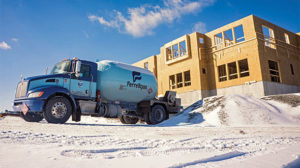
Propane provides relief from the cold for construction workers. Photo courtesy of Ferrellgas
“Over time, the market has become more specialized, and therefore there are more specialized and sophisticated heating methods in demand,” says April Gnadt, marketing product manager at the construction and event rental division of L.B. White. “There are a lot more options than just torpedo or salamander heaters these days. Also, we have seen customers stocking less than they did 10 years ago and buying more on demand.”
ProGas Inc. of Zelienople, Pennsylvania, successfully serves industrial and commercial accounts with a variety of propane-fired appliances.
“In addition to the temporary heaters themselves, we have the various hoses, carts and manifolds to go with them. We also offer temporary air conditioners, space heaters, dehumidifiers and fans,” reports Ron Schramm, president of ProGas. “A ground-thaw unit can help you cure concrete, thaw the ground for digging and excavating, prevent frost from forming on the ground and other surfaces, and warm the air around it for outdoor work.”
Serving clients throughout the Pennsylvania, Ohio and West Virginia tri-state region, ProGas representatives work with the contractor to survey the work site and recommend the proper heater type and size – including natural gas options – followed by the fast arrival of company service personnel who deliver, install and fuel the units with either 100-pound cylinders or 1,000-gallon bulk storage tanks, depending on the need.
“Cold weather can really wreak havoc when your business is working on a construction or renovation project. It can create all kinds of problems,” says Schramm, describing an assortment of calamities that can occur:
- Solvents and water in paint can freeze and make drying and curing time longer. Some paints may become too thick to apply.
- Plaster can freeze, weakening to the point where it may come off the surface at the slightest touch.
- Stucco that freezes within the first 48 hours of application will be compromised because the excess water in it expands when it freezes, which can negatively affect its durability and strength.
- Ice crystals can weaken both concrete and bricks.
- If there’s existing plumbing at a renovation site, cold temperatures can cause pipes to freeze and burst.
- Joint compound and spackle don’t adhere properly to drywall.
- Equipment may not run properly.
- Workers are vulnerable to hypothermia and frostbite. And ice on surfaces may cause slips and falls.
- Labor costs are driven up by the effects that cold weather can have on your materials and the extra time needed to finish jobs.
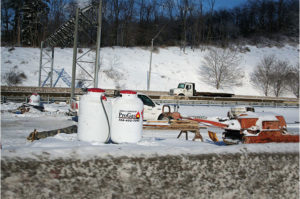
Temporary heating ensures safe working conditions and proper function of equipment and supplies on job sites. Photo courtesy of ProGas
Some 20 years ago, “as a propane company we would call on contractors to see if they needed propane as a fuel for their heating units,” Schramm recounts. “We later teamed up with a number of heating vendors and asked them to recommend us if their customers needed propane for fuel.”
With the dynamics of the marketplace changing due to ongoing consolidation among rental firms and HVAC vendors, plus a worsening decline in installation expertise, ProGas saw an opportunity to become a full-service, one-stop-shop provider of both the heaters and the fuel.
Gnadt at L.B. White reports that temporary propane heaters are often utilized at industrial locations with fixed-site diesel machinery to prevent the fuel from freezing or gelling.
“Warehouses with doors that frequently open and close are a common application of temp heat, too,” she adds.
Construction sites, party tents, and camping and sporting events tend to be the most popular applications for temporary heating. Enerco’s Mr. Heater division even offers an ultra-portable unit that fits golf cart cup holders for cozy wintertime action on the links.
“The good news about selling heaters in construction or party tent settings is they range in size to fit most any budget, and the most expensive heaters can be rented,” says Peter Donoghue, Enerco’s vice president of commercial sales and marketing. “Either way, users need to do a good job estimating fuel consumption to ensure that adequate LP supply is available at the site,” he adds, citing the company’s online energy-needs calculator, found at heatstarbyenerco.com/heater-calculator/.
Generating new business
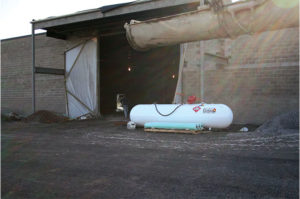
Advantages of propane on a construction site include portability and convenience. LPG can be hooked up immediately to heat a space. Photo courtesy of ProGas
The temporary propane category at Ferrellgas leads to good business in certain locations.
“In some cold weather markets it can comprise as much as 60 percent of the new business that is generated,” reports Ed Mulcahey, senior account manager at the company’s Manheim, Pennsylvania, service center.
In certain Midwestern markets, “production of 1 million gallons is not out of the question,” he adds.
“We consider hot tar roofing, refinery applications consisting of the degassing of tanks and the temporary forklift fuel requirements of racking installation companies as business in this category,” Mulcahey explains.
“The market depends on the health of the construction industry, which happens to be in a solid place at this point in time,” he adds.
Trends include a greater focus on safety and protection of the propane in storage at each site.
“The opportunities remain with protecting concrete pours and the interior finishing trades,” says Mulcahey, referencing some challenges as well: “In some cases, unrealistic requirements by municipalities present roadblocks. Increased regulation on the state level also creates some barriers.”
Overlapping markets
Industry estimates indicate that 80 percent of the construction projects using temporary heat select propane as their fuel of choice, largely due to its convenience and availability.
“Even when natural gas is available, many times you’re unable to connect to it until the project is nearly complete,” notes Jeff Head, sales and marketing manager at LPG & NH3 Supply Inc., based in Buffalo, Minnesota.
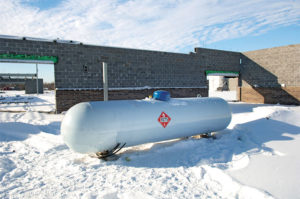
Because propane burns clean, it can help meet LEED requirements during construction of a building. Photo courtesy of Ferrellgas
The temporary heating segment is sizeable and important to propane marketers, he says. In addition to contractors, it also involves manufacturers, distributors, rental companies, hospitality businesses and retail operations. The equipment can be purchased or leased depending upon a financial analysis.
Homebuilders typically lease temporary heaters for the season and move them from site to site as needed, and in some regions, codes or safety regulations require that employees have a supplementary heat source when work-area temperatures drop below a certain level.
“Oftentimes propane is also used to serve other markets that overlap,” says Head, “such as powering job site lighting via generators and to safely and cleanly power motorized equipment used at a job site.”
Saws, trowels, burnishers, polishers, power buggies and welding equipment are some of the primary applications – “the point being that the construction industry is quite comfortable, and familiar, with using propane in multiple ways at a job site,” says Head.
Portable propane heaters can help meet LEED requirements for clean indoor air quality during the construction and pre-occupancy phases of a building.
“It’s convenient, versatile and easily transportable,” says Head. “Other fuels, like kerosene, can leave behind a dirty film.”
Electricity requires significantly more energy to get the equivalent British thermal units of propane.
“It’s affordable – propane is the most commercially viable, cost-effective solution,” adds Head.
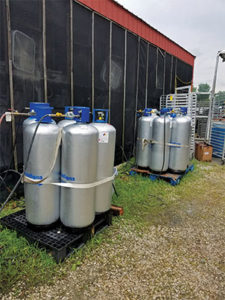
All personnel should be trained on proper storage of tanks. Photo courtesy of Ferrellgas
Typically the temporary heating market is more prevalent in the northern United States, as you might expect, but cold temperatures do indeed dip down into the South, although they don’t tend to linger for the same duration.
For marketers contemplating entry into this segment, “having the right equipment available at the right time can be tricky,” Head cautions.
“Investment is relative to the market opportunity and size. You’ll need to purchase the equipment (e.g., heaters, vaporizers, tanks, hose, fittings, valves, etc.). You’ll need to have a place to store, maintain and service the equipment,” he elaborates.
Employees need to be onboard to sell, transport, install and service the various components. Plus, it is necessary to address the business aspects, such as accounting.
Head emphasizes that everyone involved in the process needs to be thoroughly trained in the hazards and safety aspects pertaining to the equipment and fuel. Complete compliance with all of the specific appliance and work site regulations and related performance standards is crucial.
All personnel need to know about clearances for combustibles and where the shut-off valves are located, for example, along with the locations of safety devices such as fire extinguishers and training in how to use them.
Taking stock of insurance policy issues is another consideration, and there are many safety requirements requiring strict adherence:
- Cylinders must be stored outside in an upright position and secured so that they do not fall over.
- Protect the cylinders from mobile equipment moving in the area and post “no smoking” signs in the storage area.
- Do not allow mobile equipment to drive over flexible fuel lines.
“Establish written operating procedures based on the manufacturer’s instructions to ensure safe installation and operation,” Head advises.
Building relationships
Steve Clayton is the Midwest regional manager at the Gas Equipment Co., an equipment supplier with 11 branches east of the Rocky Mountains. “We sell to propane marketers,” he explains, and they in turn typically lease (or sometimes sell) the products to their end-user contractor customers.
The operation specializes in smaller units, especially those that are used during drywall construction, “generally the size of what one person can pick up and move around,” he says.
“It’s definitely a pretty niche market,” according to Clayton. “It’s bigger in larger cities – anywhere where there’s a lot of construction going on.”
Bergquist Inc., a wholesale propane equipment distributor headquartered in Toledo, Ohio, supplies safety and product training to propane marketers in addition to its temporary heating units. The marketers subsequently provide safety and product training to their building contractor customers.
Developing a process of “building your business by building relationships” is the best method for obtaining more load within the category, says Trent Johnson, the company’s Mid-Atlantic area sales manager. This technique – directed at custom builders and large building contractors – can result in both more temporary construction applications and more permanent installations.
Because of these established relationships with the construction builders, providing temporary construction heat can create propane gallon growth year after year and not just “temporarily,” he points out.
To begin forming these critical relationships, Johnson recommends that you become a member of building associations in your service areas.
“Another way to get involved is to attend project manager and site supervisor safety meetings to offer a short safety presentation of proper cylinder, tank, heater, regulator and hose locations with pictures of correct and incorrect examples,” he says.
“Yet another way to build business and credibility is to offer safety literature materials, which include simple do’s and don’ts for all construction personnel in English and other languages for use on job sites,” says Johnson. “Finally, customer service is at the core of building any business, so be available 24 hours a day, seven days a week for the general contractor, and provide personalized service.”
















